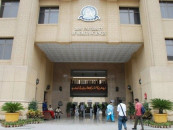Hand fans become a common sight
Citizens unable to afford generators and UPS machines, rely on traditional means to beat the heat

The bane of load-shedding is one that has gripped Karachi for several decades now, but the increased frequency of planned and unplanned electricity outages amid a national power crisis appears to have pushed the megacity back to the dark ages. Meriting a return of hand fans, considered a relic from antiquity in much of the modern world, that have started to grace port-city markets, and are fast becoming a must-have for those worst affected by constant power failures.
Starting June 2022, planned power outages of at least six to eight hours have become a routine affair in Karachi, including areas with 100 per cent billing recovery such as DHA, Clifton, Nazimabad, Saddar and a few others that were previously exempted from load-shedding.
Until last year, those who could afford, would some find respite from load-shedding by installing generators and Uninterruptible Power Supply (UPS) machines, that could at least run a few fans, bulbs and essential electronics depending on capacity. However, the radical surge in the prices of petroleum products that are used to fuel most generators have led many who already own the machine to shut it down. Whereas those with Uninterruptible Power Supply machines complain that power outages have become so prolonged and frequent that they are not even able to charge their UPS batteries, making the expensive device as good as a brick.
“My area barely gets power, and I cannot afford installing a generator let alone paying for its fuel,” said Anis, an elderly man who runs a small stationary shop in the Safoora, a neighbourhood worst -affected by load-shedding. “It can get incredibly stuffy in the shop during the day, and this hand fan is my only respite from the heat,” he added, fanning his face to dry off his sweat. Similarly, Shafi Mohammad, who sells confectionaries out of a movable cabin stationed Abdullah Haroon Road also relies on his hand fan to beat the heat, or at least try. “I just got this fan when I saw it in the market. Before that, I’d use a newspaper or a cardboard to fan myself, “said the cabin owner, who upon seeing the wider need for the product, has now started selling hand fans from his own kiosk.
Per Shafi Mohammad, there is a great demand for hand fans in market areas like Saddar and middle and low-income neighbourhoods. “There are different varieties of hand fans available, but I sell the cheapest ones that I get from Banaras, and retail for Rs50 to Rs30 depending on how keen a customer is on bargaining. The best variety of hand fans is sold at Jodia Bazar, but those fans are upwards of Rs50 in price and are brought from rural Sindh and Punjab where hand fans other than a necessity are also an item of cultural significance,” he shared.
Speaking in the regard, senior culture writer Ijaz Sheikh said that hand fans are usually made in areas where there are more palm trees. Most palm trees in Sindh are available in Khairpur and Sukkur districts. Sheikh, who himself belongs to a village in Khairpur, said that hand fans are usually made by rural women, who are experts in the craft.
“Traditionally, hand fans are made from the leaves of the palm tree but not all the leaves of the tree are useful for it. There is a clump of four to six leaves at the top of each palm trees, and that is what the women use to make the fans and then decorate them with vibrantly coloured treads and accessories, which is why they are more expensive mass produced plastic hand fans” he told The Express Tribune.
Published in The Express Tribune, July 19th, 2022.



















COMMENTS
Comments are moderated and generally will be posted if they are on-topic and not abusive.
For more information, please see our Comments FAQ